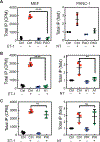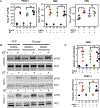Phosphatidylinositol 4-phosphate is a major source of GPCR-stimulated phosphoinositide production
- PMID: 30206135
- PMCID: PMC6413320
- DOI: 10.1126/scisignal.aan1210
Phosphatidylinositol 4-phosphate is a major source of GPCR-stimulated phosphoinositide production
Abstract
Phospholipase C (PLC) enzymes hydrolyze the plasma membrane (PM) lipid phosphatidylinositol 4,5-bisphosphate (PI4,5P2) to generate the second messengers inositol trisphosphate (IP3) and diacylglycerol (DAG) in response to receptor activation in almost all mammalian cells. We previously found that stimulation of G protein-coupled receptors (GPCRs) in cardiac cells leads to the PLC-dependent hydrolysis of phosphatidylinositol 4-phosphate (PI4P) at the Golgi, a process required for the activation of nuclear protein kinase D (PKD) during cardiac hypertrophy. We hypothesized that GPCR-stimulated PLC activation leading to direct PI4P hydrolysis may be a general mechanism for DAG production. We measured GPCR activation-dependent changes in PM and Golgi PI4P pools in various cells using GFP-based detection of PI4P. Stimulation with various agonists caused a time-dependent reduction in PI4P-associated, but not PI4,5P2-associated, fluorescence at the Golgi and PM. Targeted depletion of PI4,5P2 from the PM before GPCR stimulation had no effect on the depletion of PM or Golgi PI4P, total inositol phosphate (IP) production, or PKD activation. In contrast, acute depletion of PI4P specifically at the PM completely blocked the GPCR-dependent production of IPs and activation of PKD but did not change the abundance of PI4,5P2 Acute depletion of Golgi PI4P had no effect on these processes. These data suggest that most of the PM PI4,5P2 pool is not involved in GPCR-stimulated phosphoinositide hydrolysis and that PI4P at the PM is responsible for the bulk of receptor-stimulated phosphoinositide hydrolysis and DAG production.
Copyright © 2018 The Authors, some rights reserved; exclusive licensee American Association for the Advancement of Science. No claim to original U.S. Government Works.
Conflict of interest statement
Figures








Similar articles
-
Sustained diacylglycerol accumulation resulting from prolonged G protein-coupled receptor agonist-induced phosphoinositide breakdown in hepatocytes.J Cell Biochem. 2005 Feb 1;94(2):389-402. doi: 10.1002/jcb.20260. J Cell Biochem. 2005. PMID: 15526278
-
G protein βγ subunits regulate cardiomyocyte hypertrophy through a perinuclear Golgi phosphatidylinositol 4-phosphate hydrolysis pathway.Mol Biol Cell. 2015 Mar 15;26(6):1188-98. doi: 10.1091/mbc.E14-10-1476. Epub 2015 Jan 21. Mol Biol Cell. 2015. PMID: 25609085 Free PMC article.
-
PLCγ1 participates in protein transport and diacylglycerol production triggered by cargo arrival at the Golgi.Traffic. 2015 Mar;16(3):250-66. doi: 10.1111/tra.12246. Epub 2015 Jan 6. Traffic. 2015. PMID: 25491205
-
Regulation of phosphatidylinositol-specific phospholipase C at the nuclear envelope in cardiac myocytes.J Cardiovasc Pharmacol. 2015 Mar;65(3):203-10. doi: 10.1097/FJC.0000000000000195. J Cardiovasc Pharmacol. 2015. PMID: 25658460 Free PMC article. Review.
-
Phosphatidylinositol 4,5-bisphosphate in the Control of Membrane Trafficking.Int J Biol Sci. 2020 Aug 25;16(15):2761-2774. doi: 10.7150/ijbs.49665. eCollection 2020. Int J Biol Sci. 2020. PMID: 33061794 Free PMC article. Review.
Cited by
-
Exploring Novel Antidepressants Targeting G Protein-Coupled Receptors and Key Membrane Receptors Based on Molecular Structures.Molecules. 2024 Feb 22;29(5):964. doi: 10.3390/molecules29050964. Molecules. 2024. PMID: 38474476 Free PMC article. Review.
-
Direct evidence that the GPCR CysLTR2 mutant causative of uveal melanoma is constitutively active with highly biased signaling.J Biol Chem. 2021 Jan-Jun;296:100163. doi: 10.1074/jbc.RA120.015352. Epub 2020 Dec 11. J Biol Chem. 2021. PMID: 33288675 Free PMC article.
-
Non-canonical Golgi-compartmentalized Gβγ signaling: mechanisms, functions, and therapeutic targets.Trends Pharmacol Sci. 2023 Feb;44(2):98-111. doi: 10.1016/j.tips.2022.11.003. Epub 2022 Dec 7. Trends Pharmacol Sci. 2023. PMID: 36494204 Free PMC article. Review.
-
Molecular basis for plasma membrane recruitment of PI4KA by EFR3.Sci Adv. 2024 Dec 20;10(51):eadp6660. doi: 10.1126/sciadv.adp6660. Epub 2024 Dec 20. Sci Adv. 2024. PMID: 39705356 Free PMC article.
-
Structure of phospholipase Cε reveals an integrated RA1 domain and previously unidentified regulatory elements.Commun Biol. 2020 Aug 14;3(1):445. doi: 10.1038/s42003-020-01178-8. Commun Biol. 2020. PMID: 32796910 Free PMC article.
References
-
- Kadamur G, Ross EM, Mammalian phospholipase C. Annu. Rev. Physiol 75, 127–154 (2013). - PubMed
-
- Yang YR, Follo MY, Cocco L, Suh P-G, The physiological roles of primary phospholipase C. Adv. Biol. Regul 53, 232–241 (2013). - PubMed
-
- Cocco L, Martelli AM, Billi AM, Cataldi A, Miscia S, Mottola MR, Manzoli L, Phospholipids as components of the nuclear matrix: Their possible biological significance. Basic Appl. Histochem 31, 413–419 (1987). - PubMed
Publication types
MeSH terms
Substances
Grants and funding
LinkOut - more resources
Full Text Sources
Other Literature Sources
Research Materials
Miscellaneous

